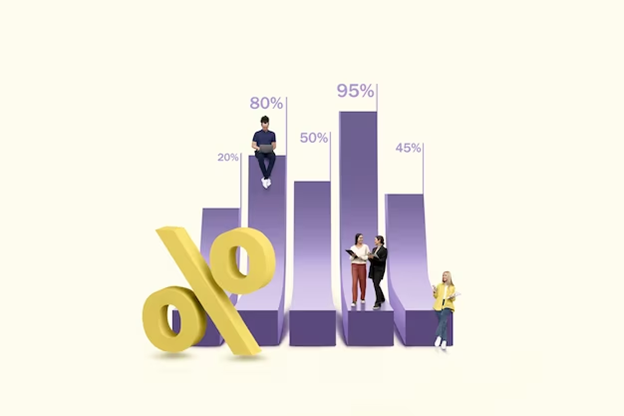Measuring the impact of your online efforts is paramount in the present world. It’s no secret that social media has become a central hub for businesses and individuals alike. But how do you effectively measure social listening, the practice of tracking online conversations, and understanding audience sentiments?
As of the latest statistics on social listening by SocialMediaToday, 82% of companies believe that social listening is crucial for their success. In this article, we’ll delve into the world of measuring social listening, exploring the strategies, tools, and key metrics that help you quantify the impact of your social media presence and ensure your efforts are yielding tangible results.
Let’s unravel the science of how to measure social media listening.
 Social listening is a powerful tool that helps businesses understand what people are saying about their brand, products, or industry on social media platforms and other online channels. It involves actively monitoring and analyzing conversations, comments, and mentions across various social media platforms like Facebook, Twitter, Instagram, and more.
The main goal of social listening is to gain valuable insights into customer opinions, sentiments, and trends. By tracking keywords, hashtags, and specific phrases related to their brand or industry, businesses can identify emerging trends and gauge public sentiment. For instance, a clothing company can track mentions of its products to understand which designs are popular and which ones need improvement.
Furthermore, social listening allows companies to engage with their audience more effectively. By responding promptly to customer feedback, businesses can address concerns, resolve issues, and build stronger relationships with their customers.
For example, if a restaurant receives negative reviews about its service on social media, it can quickly respond with an apology and an improvement plan, showing customers that their opinions are valued.
Social listening is a powerful tool that helps businesses understand what people are saying about their brand, products, or industry on social media platforms and other online channels. It involves actively monitoring and analyzing conversations, comments, and mentions across various social media platforms like Facebook, Twitter, Instagram, and more.
The main goal of social listening is to gain valuable insights into customer opinions, sentiments, and trends. By tracking keywords, hashtags, and specific phrases related to their brand or industry, businesses can identify emerging trends and gauge public sentiment. For instance, a clothing company can track mentions of its products to understand which designs are popular and which ones need improvement.
Furthermore, social listening allows companies to engage with their audience more effectively. By responding promptly to customer feedback, businesses can address concerns, resolve issues, and build stronger relationships with their customers.
For example, if a restaurant receives negative reviews about its service on social media, it can quickly respond with an apology and an improvement plan, showing customers that their opinions are valued.
 Engagement metrics are crucial when we measure social listening as they reflect how interactively your audience communicates with your brand. This includes likes, shares, comments, and responses to social media posts. High engagement rates often correlate with higher brand loyalty and customer satisfaction.
Engagement metrics are crucial when we measure social listening as they reflect how interactively your audience communicates with your brand. This includes likes, shares, comments, and responses to social media posts. High engagement rates often correlate with higher brand loyalty and customer satisfaction.
 Finally, measuring the ROI of social media efforts is essential in social listening. This involves linking social media metrics to business outcomes like sales, customer retention rates, and brand equity to assess the financial value of social media engagements.
Incorporating these components into your social listening strategy can provide a holistic view of your brand’s online presence and performance. Through consistent monitoring and analysis, it becomes possible to fine-tune communication strategies, improve customer relationships, and ultimately drive business growth.
It’s important to leverage social listening tools that can automate and assist with this analysis, providing actionable insights that can help shape strategic decisions.
Also Read : The Psychology Of Online Reputation: How Perception Influences Digital Success
Finally, measuring the ROI of social media efforts is essential in social listening. This involves linking social media metrics to business outcomes like sales, customer retention rates, and brand equity to assess the financial value of social media engagements.
Incorporating these components into your social listening strategy can provide a holistic view of your brand’s online presence and performance. Through consistent monitoring and analysis, it becomes possible to fine-tune communication strategies, improve customer relationships, and ultimately drive business growth.
It’s important to leverage social listening tools that can automate and assist with this analysis, providing actionable insights that can help shape strategic decisions.
Also Read : The Psychology Of Online Reputation: How Perception Influences Digital Success
What is Social Listening?
 Social listening is a powerful tool that helps businesses understand what people are saying about their brand, products, or industry on social media platforms and other online channels. It involves actively monitoring and analyzing conversations, comments, and mentions across various social media platforms like Facebook, Twitter, Instagram, and more.
The main goal of social listening is to gain valuable insights into customer opinions, sentiments, and trends. By tracking keywords, hashtags, and specific phrases related to their brand or industry, businesses can identify emerging trends and gauge public sentiment. For instance, a clothing company can track mentions of its products to understand which designs are popular and which ones need improvement.
Furthermore, social listening allows companies to engage with their audience more effectively. By responding promptly to customer feedback, businesses can address concerns, resolve issues, and build stronger relationships with their customers.
For example, if a restaurant receives negative reviews about its service on social media, it can quickly respond with an apology and an improvement plan, showing customers that their opinions are valued.
Social listening is a powerful tool that helps businesses understand what people are saying about their brand, products, or industry on social media platforms and other online channels. It involves actively monitoring and analyzing conversations, comments, and mentions across various social media platforms like Facebook, Twitter, Instagram, and more.
The main goal of social listening is to gain valuable insights into customer opinions, sentiments, and trends. By tracking keywords, hashtags, and specific phrases related to their brand or industry, businesses can identify emerging trends and gauge public sentiment. For instance, a clothing company can track mentions of its products to understand which designs are popular and which ones need improvement.
Furthermore, social listening allows companies to engage with their audience more effectively. By responding promptly to customer feedback, businesses can address concerns, resolve issues, and build stronger relationships with their customers.
For example, if a restaurant receives negative reviews about its service on social media, it can quickly respond with an apology and an improvement plan, showing customers that their opinions are valued.
Why is Measuring Social Listening Important?
Measuring social listening is of paramount importance for businesses in today’s digital age. It goes beyond just tracking mentions and comments on social media platforms; it involves a deeper analysis of data to understand the impact and implications of online conversations. Here’s why measuring social listening is crucial:- Data-Driven Insights: Social listening measurement provides businesses with data-driven insights into customer sentiments and opinions. By analyzing this data, companies can make informed decisions about their products, services, and marketing strategies.
- Sentiment Analysis: Sentiment analysis in social listening allows organizations to gauge whether online conversations about their brand or products are positive, negative, or neutral. This information is vital for understanding public perception and reputation management.
- Performance Evaluation: Measuring social media listening helps in evaluating the performance of marketing campaigns and strategies. Businesses can track how well their content resonates with the audience and make adjustments accordingly.
- Competitive Analysis: Companies can use social listening to keep an eye on their competitors. By monitoring what people are saying about competing brands, businesses can identify opportunities and threats in the market.
- Customer Engagement: Measuring social listening enables businesses to measure their reach and influence on social media. They can determine how effectively they engage with their audience and whether their messages resonate with their target demographics.
- Crisis Management: Social listening measurement is essential for the early detection of potential crises. If negative sentiment starts to rise, companies can take proactive steps to address issues before they escalate.
- Product Development: By analyzing the feedback and suggestions shared by customers on social media, businesses can gather valuable insights for product development and improvement.
How to Measure Social Listening?
Measuring social listening involves a range of metrics and techniques that enable brands to gauge the effectiveness of their social media strategies and understand the perceptions and needs of their customers. To provide comprehensive insights, let’s delve into the various aspects of how to measure social listening effectively.Volume of Mentions
When we measure social listening, a primary indicator is the volume of mentions. This refers to the count of how often your brand, product, or service is mentioned across social media platforms. An increase in mentions can signal a rise in brand awareness, while a sudden spike may indicate either a positive buzz or a potential PR crisis.Sentiment Analysis
Engagement tracking in social media listening is not just about numbers; it’s also about emotions. Sentiment analysis involves categorizing these mentions into positive, negative, or neutral sentiments. It provides a qualitative layer to the quantitative data, helping brands understand how their audience feels about them.Engagement Metrics
 Engagement metrics are crucial when we measure social listening as they reflect how interactively your audience communicates with your brand. This includes likes, shares, comments, and responses to social media posts. High engagement rates often correlate with higher brand loyalty and customer satisfaction.
Engagement metrics are crucial when we measure social listening as they reflect how interactively your audience communicates with your brand. This includes likes, shares, comments, and responses to social media posts. High engagement rates often correlate with higher brand loyalty and customer satisfaction.
Influence and Reach
Reach and influence measurement through social listening evaluates how far your content spreads and the impact it has. It looks at the number of unique users who have seen your post (reach) and how influential the participants in the conversation are (influence). Brands aim for a wide reach and engagement from influential users to maximize their message’s impact.Share of Voice
Share of voice in social listening is a critical metric that businesses use to gauge their online presence and competitiveness within their industry. This metric measures how much of the online conversation about a particular industry or topic is centered around your brand versus your competitors. In essence, it quantifies the extent to which your brand is heard and acknowledged in the digital realm by your competitors. Share of voice is a key indicator that helps brands measure social listening, showing how well they are performing in terms of being a part of the ongoing online discussions. Also Read : 8 Ways To Use Social Listening To Gain Competitive AdvantageCompetitor Benchmarking
Competitor benchmarking is a strategic practice essential for businesses looking to measure social listening. It entails the systematic comparison of your social listening metrics with those of your competitors. By doing so, you gain valuable insights into your brand’s performance relative to others in your industry. This comparison spans various key metrics, including share of voice, sentiment analysis, and engagement levels. Benchmarking allows you to gauge how well your brand fares in terms of online visibility and customer sentiment, helping you make data-driven decisions to improve your position and competitiveness within the industry landscape.Top Keywords and Topics
Identifying top keywords and topics is a part of effective social listening measurement. It involves analyzing the most frequently used words or phrases in conversations related to your brand, which can inform content strategy and product development.Geographic Insights
Geographic insight in social listening helps brands understand where conversations are happening. This can be crucial for localized marketing strategies and for companies operating in multiple regions to tailor their messaging according to cultural nuances and regional preferences.Customer Sentiment Trends
Analyzing customer sentiment trends over time is a fundamental way to measure social listening. This advanced form of sentiment analysis takes into account the evolution of public opinion, enabling brands to spot patterns, predict behaviors, and make informed decisions. It’s particularly valuable for long-term strategy development, as it provides insights into how customer sentiment changes and guides businesses in aligning their approaches with evolving public perceptions, ultimately ensuring sustained success in the dynamic digital landscape. Also Read : How to improve customer experience?Lead Generation and Conversion
Measuring social listening can also contribute to lead generation and conversion tracking. By monitoring conversations, brands can identify potential leads and track how social media interactions lead to conversions, whether it’s a sale, a subscription, or another form of customer acquisition.Customer Feedback and Insights
Harnessing direct customer feedback and insights is a crucial aspect of being able to measure social listening effectively. Through social listening, businesses gain access to unfiltered and candid customer opinions. This direct line to customer sentiments can be more immediate and candid than traditional feedback methods. These insights are invaluable for informing product development, refining customer service, and shaping overall business strategies, allowing companies to stay responsive to evolving customer preferences and needs in today’s dynamic market landscape.Return on Investment (ROI)
 Finally, measuring the ROI of social media efforts is essential in social listening. This involves linking social media metrics to business outcomes like sales, customer retention rates, and brand equity to assess the financial value of social media engagements.
Incorporating these components into your social listening strategy can provide a holistic view of your brand’s online presence and performance. Through consistent monitoring and analysis, it becomes possible to fine-tune communication strategies, improve customer relationships, and ultimately drive business growth.
It’s important to leverage social listening tools that can automate and assist with this analysis, providing actionable insights that can help shape strategic decisions.
Also Read : The Psychology Of Online Reputation: How Perception Influences Digital Success
Finally, measuring the ROI of social media efforts is essential in social listening. This involves linking social media metrics to business outcomes like sales, customer retention rates, and brand equity to assess the financial value of social media engagements.
Incorporating these components into your social listening strategy can provide a holistic view of your brand’s online presence and performance. Through consistent monitoring and analysis, it becomes possible to fine-tune communication strategies, improve customer relationships, and ultimately drive business growth.
It’s important to leverage social listening tools that can automate and assist with this analysis, providing actionable insights that can help shape strategic decisions.
Also Read : The Psychology Of Online Reputation: How Perception Influences Digital Success
